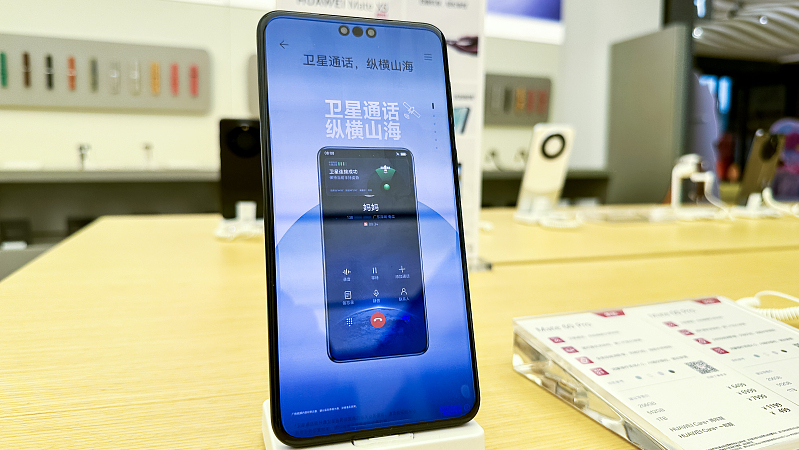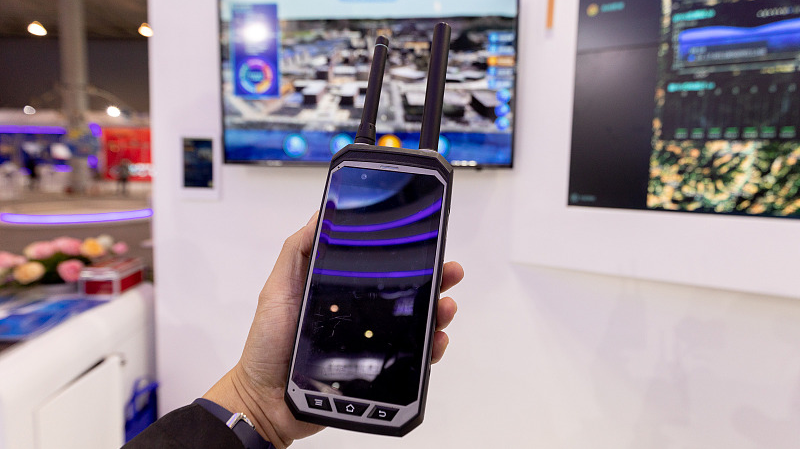
Customers try out the newly launched Huawei Mate 60 Pro at a store in Shanghai, September 3, 2023. /CFP
Customers try out the newly launched Huawei Mate 60 Pro at a store in Shanghai, September 3, 2023. /CFP
The surprise launch of Huawei's Mate 60 phones recently brought public attention to a niche technology that could rewrite the landscape of the modern wireless communication industry. The mobile satellite service, which enables users to make connections via satellite, has been gaining commercial momentum worldwide, including in China, the world's largest smartphone market.
Affordable mobile phones directly connected to satellite have suddenly become a crowded market. Last year, Apple rolled out its satellite short message for emergency service, which helps all its phone users send text messages via the low Earth orbit (LEO) Globalstar satellite outside of the cellular coverage area. Chinese phone maker Huawei also offered texting service via China's BeiDou satellite network in the same year.
This September, the U.S. firm AST SpaceMobile announced that it successfully routed a 5G call with an unmodified smartphone through one of its satellites. SpaceX's Starlink, which operates over 5,000 LEO satellites, said its direct-to-cell satellite phone service is "coming in 2024." Many telecom operators are joining the arena to expand mobile's connectivity through various approaches involving satellites.
China has gained an edge in the race thanks to years of development prior to the official launch.
"Huawei indeed is one of the first mobile phones directly connected to satellite, and it's via geosynchronous (GEO) satellites, which is much more difficult than low Earth orbit satellites technically," said Liu Yue, deputy head of China Telecom Corporation Limited Satellite Communication Branch, which led the R&D team of mobile phones directly connected to satellite service for Huawei's Mate 60 Pro.
A challenge in building a handy portable mobile phone that is directly connected to a satellite is making smaller antennas while still maintaining a smooth connection. The common GEO satellite phones have large external antennas, making them bulky, which provide powerful signals by receiving them from over 36,000 km away.
China Telecom collaborated with Huawei to overcome the challenge and provide satellite service in a regular smartphone format by applying higher technical standards. "It's not enough to just be able to get through phone calls with satellite. The satellite call connection success ratio needs to hit 95 percent so that we can provide carrier-grade service for our users, ensuring their experience," Liu said.
He also mentioned that the chipsets for the satellite function are also facing a similar problem. "The chipset needs to be smaller to fit in the smartphone." But smaller chipsets are harder to cool down. Liu said they developed diverse approaches to help the chipset dissipate the heat, such as saving energy consumption when users stop talking and using advanced capillary circulation cooling technology.
"We also need to connect the satellite network and 4/5G network to allow users to freely roam between the satellite and terrestrial networks," Liu added. "Innovation comes from every bit of detail."

The Huawei Mate 60 Pro has satellite cell service with no large antenna on the phone. /CFP
The Huawei Mate 60 Pro has satellite cell service with no large antenna on the phone. /CFP
Terrestrial vs. satellite communication
Compared to terrestrial networks such as the traditional 4G and 5G services people use on a daily basis, communication via satellites has distinctive advantages as well as disadvantages. A GEO satellite is able to cover a vast area to provide communication signals, but its capacity is substantially low.
"China has millions of Node B base stations, each of which can generate 4 gigabits per second peak data rates. Compared to that, a high-throughput, high-orbit satellite only has a capacity of about 100 gigabits, while just one satellite launch can cost several billions."
"So satellite communication capability is not about capacity," Liu pointed out. "It solves the problem when the territorial network is unreachable. The satellites' capacity won't be huge, but it gives necessary connectivity for people in dire need."
However, sometimes there're still challenges neither of the communication methods could solve, according to Liu. One example is when ships go through a channel in the Three Gorges of the Yangtze River. "It's tough to set up a telecom base station in the steep mountains along the river, but at the same time, it's tricky for the satellite to send signals down as the mountains might block its route."

The traditional satellite phone has large antennas attached to receive powerful signals from the satellite. /CFP
The traditional satellite phone has large antennas attached to receive powerful signals from the satellite. /CFP
The more, the merrier? Not in this case
Currently, the satellite communication service costs 10 yuan ($1.37) per month to subscribe. The package includes two minutes of calling time, according to Liu. However, it takes nine yuan per minute after two minutes, which is much more expensive compared to common phone calls.
"The function is quite extensive indeed, which is intentional to prevent a certain group from making unnecessary satellite phone calls. If everybody uses satellite phone calling, the network will crash, and nobody can benefit from it at all."
The satellite phone call service is for the users who actually need it. "If people go to sea fishing or drive to the Lop Nor desert, where they lose signal, satellite phone calling is right on and essential," said Liu.
The institute is working on expanding the capacity of the satellite in the hope of providing more services for more customers in the future. Liu said the application of the GEO orbit satellites deserves a chance for further development, as China has been pushing forward the development of LEO satellite constellations. "We think the combination of the LEO and GEO satellites will help provide better service to users. If we are planning to have more people enjoy satellite services, we should explore GEO satellites."
Network from ground to space
The Tiantong-1 system is the country's first self-developed mobile communications satellite system and currently has three satellites operating in orbit while only one satellite hovers over China's territory.
"It's better for two satellites to cover the area as backup for each other. In the future, we expect to build up a global GEO satellite telecom system," said Liu. "Once the low-orbit satellites take shape, we can collaborate on both."
Liu revealed that Huawei is their first phone brand client to work for the satellite call service. "We are undergoing tests with more phone makers to add the satellite calling function," he said.
Apart from cellphones, China Telecom Satellite Research Institute is developing a built-in satellite communication function on vehicles, aiming for a wider consumer market. "In the near future, the built-in satellite function as part of the Internet of Vehicles will be indispensable," Liu said.
Liu added that technological advances on this front will be based on cooperation in technology, cellular frequency and network architecture. "In the future, the key will be merging the satellite network and the terrestrial network into one system, which is the only road to push forward the development of satellite networks on a large scale."